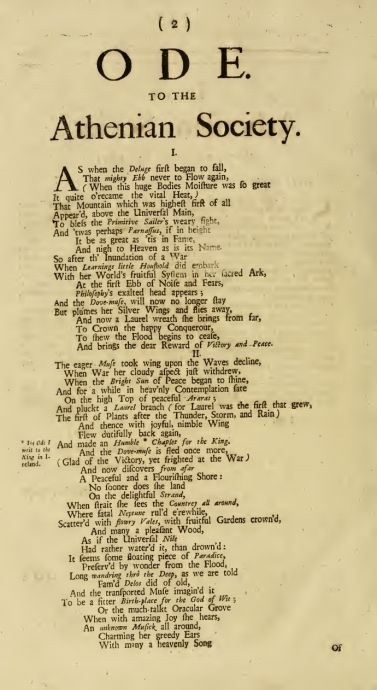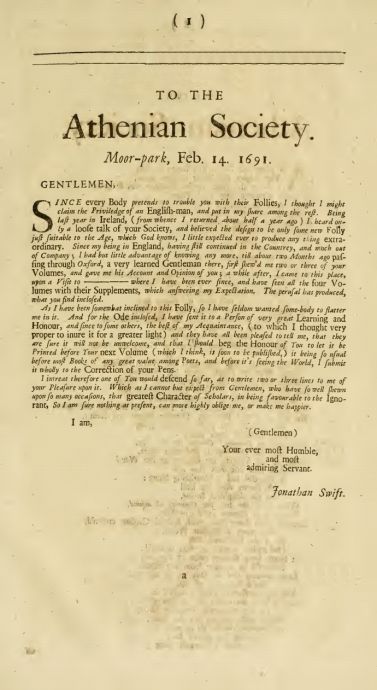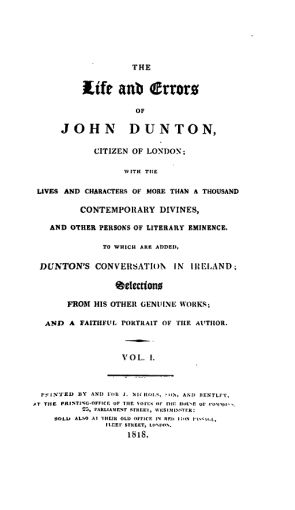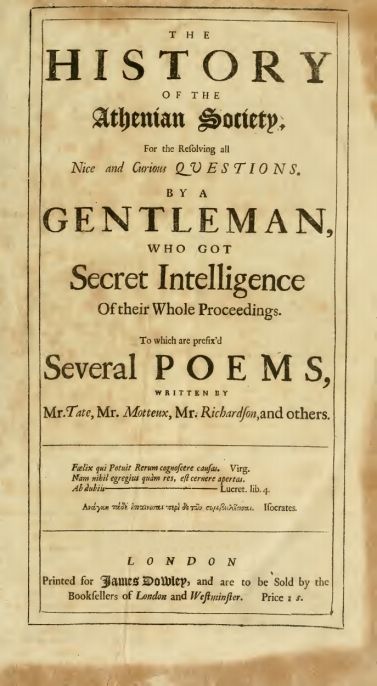nn
n
n The Athenian Mercury was instantly extremelynpopular and was critically feted by such luminaries as Jonathan Swift, SirnThomas Blount and Nahum Tate, (later to be the Poet Laureate).
n
n
n
 |
| Jonathan Swift – Ode to the Athenian Society – 1691 |
n
n
n
nJonathan Swiftneven wrote an Ode in praise of it, his first published work, but thenyoung Swift had not yet reached his later powers and his 307-line Odenled John Dryden, the pre-eminent dramatist, literary critic and the then PoetnLaureate to remark, “Cousin Swift, you will never be a poet,” an asidenthat fostered a life-long animosity to Dryden in Swift.
n
n
n
 |
| Jonathan Swift’s ‘Fan Letter’ to the Athenian Society |
n
n
n
nThe Athenian Mercuryndeclared that it was not confined
n
n
n
n“… to answer all manner of Nice andnCurious Questions of Divinity, Physick, Law, Philosophy, History, Trade,nMathematicks &c” but every ‘Natural and Artificial Rarities of thenKnown World.’n
n
n
n
n
 |
| John Dunton |
n
n
n
nThe first ever question to be answered in The AtheniannGazette was,
n
n
n
n“Whether the Torments of the damn’d are visible to thenSaints in Heaven? and vice versa?”n
n
n
nand the range of the publicationnconsidered many such esoteric topics; half a dozen of the questions, chosen atnrandom, illustrate the extensive compass of the paper –
n
n
n
- How came the spots on the Moon?
n
- I knew a Gentlewoman who wept the first Night she slept with hernHusband, Whether was it Joy, Fear or Modesty that caus’d these tears?
n
- Whether anCircle may be squared; that is, what demonstration can be made of the Equalitynbetwixt a Circle and a Square?
n
- Whether if Females went a courting, there wou’dnnot be more Marriages than now there are?
n
- Why do Scotchmen hate Swines-Flesh?n
n
- Whether a Woman may be believed when she says she’ll never marry?
n
n
n
nAs itnturned out, there was such a disproportionately high number of questions aboutnrelationships and sex, that in February 1693, The Ladies’ Mercurynappeared, for a scant four weeks, in response to an enquiry by a gentlewomannwho wanted to know if the Mercury accepted questions from the fairernsex; it was the first publication, a single sheet printed on both sides, aimednat an entirely female audience.
n
n
n
 |
| The Life and Errors of John Dunton – 1705 |
n
n
n
nThe questions raised, and the answers given,nprovide a unique insight into the concerns, attitudes and preconceptions of thenlate seventeenth century, and a fascinating glimpse into the language used bynordinary people, in contrast to the literary language employed by poets,ndramatists and the like.
n
n
n
nSometimes, the answers are not what we might expect,ngiven our own misconceptions of what we might consider to be thosenunenlightened times. Take this question from Volume 3, Number 29 – WhethernNegroes shall rise so at the Last Day? The implication is that ‘negroes’nare somehow imperfect and need necessarily to become white before they can gonto Heaven. The given answer is refreshingly surprising,
n
n
n
n“The Pinch of thenQuestion only lies— Whether White or Black, is the better Colour? For thenNegroes won’t be persuaded but their Jett is finer and more beautiful than ournAlabaster. — If we Paint the Devil black, they are even with us, for they Paintnhim white, and no doubt on’t are as much in the right on’t as we.”n
n
n
nIt is anreflection on the importance placed on the Classics at the time, that prettynsoon a rival publication called The Lacedemonian Mercury appeared, andnobservers would have been expected to know that Lacedemonian was another termnfor the Spartans, the ancient Greek rivals of the Athenians. Dunton respondednwith typical ingenuity, he advised readers of the imitator to resubmit theirnquestions to the Athenian Mercury, where they would be properly amendednand answered correctly. The Athenians physically faced up to the Lacedemoniansnin the Three Cranes tavern, with Richard Sault threatening at one stagento draw his sword on Mr Thomas Brown, the rival editor, for an ‘incivility’,nwhereupon everyone saw sense and the spurious Spartans withdrew in disarray.
n
n
n
 |
| The Life and Errors of John Dunton – 1705 (1818 edition) |
n
n
n
nAnother attack came soon after, when a scurrilous play was staged,
n
n
n
n“The NewnAthenian Comedy; containing the Politicks, Oeconomicks, Tacticks, Crypticks,nApocalypticks, Stypticks, Scepticks, Pneumaticks, Theologicks, and Dogmaticksnof our most learned Society,”n
n
n
nwritten by Elkanah Settle, it presented thenmembers of an Athenian Society meeting over a dinner of black pudding atnSmith’s Coffee House, to decide such weighty matters as ‘Which is thennoblest animal; the Louse or the Flea?’ or answering the amatory queries ofnan Islington milkmaid, Dorothy Ticklecat, who pays for the answers withnstrawberries and cream. This obscene ‘comedy’ was unsuccessful, and Duntonnremarked in his autobiography, The Life and Errors of John Duntonn(1705), that ‘… there was nothing of Wit through the whole of it,’ andnits only achievement was to further popularise the Mercury.
n
n
n
 |
| Charles Gildon – The History of the Athenian Society – 1692 |
n
n
n
nConversely,nCharles Gildon wrote an effusive The History of the Athenian Societyn(1692), which was prefaced with complimentary poems by the likes of Tate andnDefoe and, like the Mercury, scatters capital letters, apostrophes and anvariety of typefaces around with neither apparent rhyme nor orthologicalnreason.
n
n
n
 |
| The Athenian Society |
n
n
n
nIt also featured an illustration of the imagined Athenian Society innall their glory, sitting at a long table with quills in hand and receivingnquestions from a gathered multitude, with more arriving in coaches, and at onenside an angel rescues a man on the gallows whilst his companion cries, “Help,nhelp, noble Athenians.” In the corners are the cities of Athens, Rome,nOxford and Cambridge, and at the top left, a monkey forces a cat to pullnroasting chestnuts from a fire, indicating that the Athenians are well aware ofnthe dangers of getting ones fingers burned.
n
n
n
 |
| Live by Rapine |
n
n
n
nThe individual parts of ThenAthenian Mercury were published in volumes of thirty numbers, together withnan added supplement, stitched into marble papers for half-a-crown each, withnnineteen volumes issued up until February 1696, before an advertisement in thenthirtieth part announced,
n
n
n
n“That the proprietor of the Athenian Mercurynthinks fit, whilst the coffee-houses have the Votes every day, and sixnnewspapers every week, to discontinue this Weekly paper (the nineteenth volumenbeing now finished), and carry on the said design in volumes; and, in pursuancenof this resolution, thirty Numbers shall speedily be printed altogether, toncomplete the twentieth volume; the first undertaker designs to have itncontinued in weekly papers as soon as ever the glut of news is a little over.”n
n
n
n Notwithstanding this inconsiderate glut of news, the first number of the 20thnedition did not appear until May 1697, and did not extend beyond the tenthnnumber, on June 14th of that year.
n
n
n
nBut that was not the death of ThenAthenian Mercury. Almost, but not quite.
n
n
n
nTomorrow – What happened next…



















